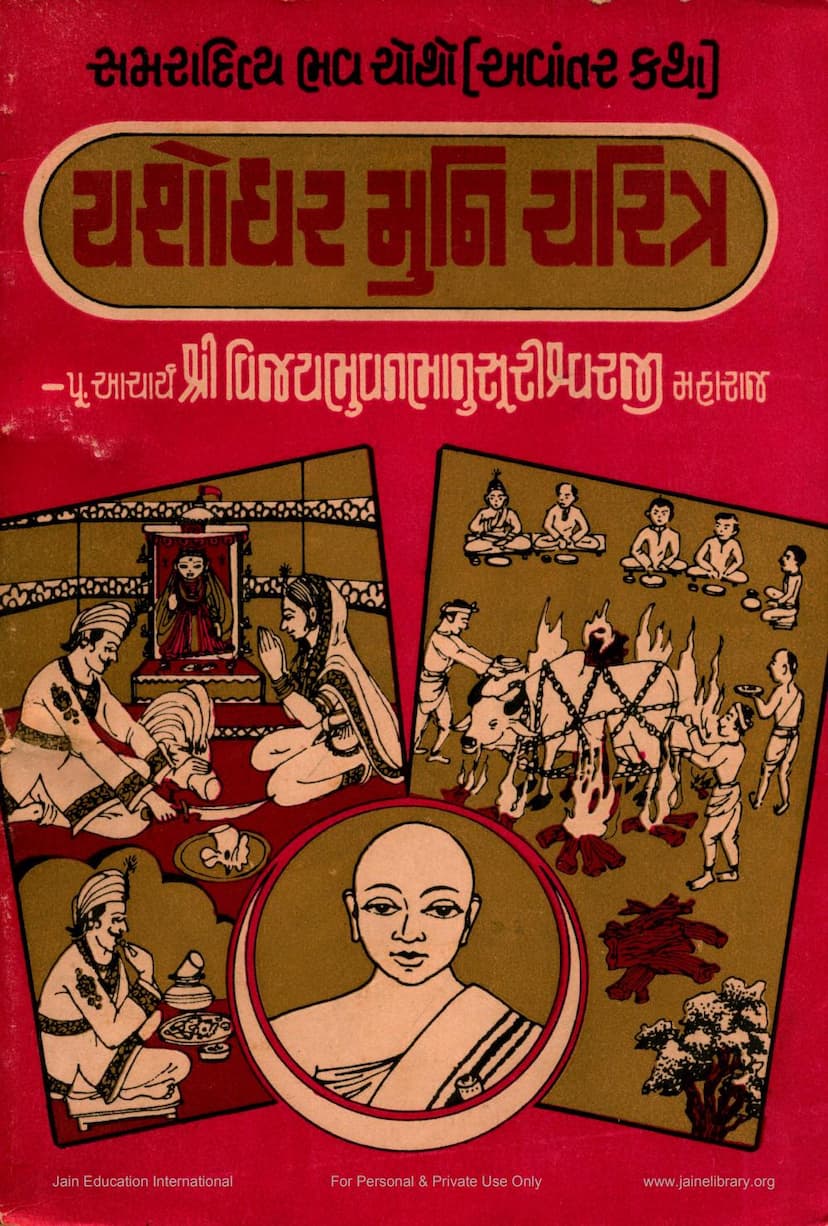Yashodharmuni Charitra
Added to library: September 2, 2025

Summary
Here's a comprehensive summary of the Jain text "Yashodharmuni Charitra" by Bhuvanbhanusuri, based on the provided pages:
Title: Yashodharmuni Charitra (The Biography of Yashodhar Muni) Author: Pujya Acharya Shri Vijay Bhuvanbhanusurishwarji Publisher: Divyadarshan Sahitya Prakashan Samiti Catalog Link: https://jainqq.org/explore/005480/1
Overview:
The text is part of a larger work, likely "Samraditya Kathaa" (The Tales of Samraditya), which describes the nine previous lives of the Jain ascetic Samraditya. This particular section, "Yashodharmuni Charitra," focuses on the fourth rebirth within Samraditya's narrative, where he appears as Yashodhar Muni. The book is a compilation of stories and teachings, presented in a way that aims to inspire detachment (vairagya) and spiritual awakening (samveg) in the reader. The publisher and editor emphasize that the stories within the Jain tradition are profound and aim to lead individuals towards a better understanding of life, karma, and spiritual liberation.
Key Themes and Content:
-
The Story of Samraditya and Yashodhar Muni: The text is an "antar Katha" (sub-story) within the nine lives of Samraditya. In the fourth life, the protagonist, Samraditya's soul, is reborn as Dhanakumar Shreshthi's son in the city of Anandpur. He marries Dhanashri, who is later revealed to be the soul of Agnisharma Tapas from Samraditya's first life, harboring an ancient enmity. Dhanakumar is pushed into the ocean by Dhanashri. Through divine intervention and fortunate circumstances, he survives and eventually encounters Mahatma Yashodhar Muni, whose life story profoundly impacts him, leading to a spiritual turning point.
-
The Character of Yashodhar Muni: The text delves into the virtues and qualities of Yashodhar Muni. He is described as a lion among ascetics (shramanasimha) due to his spiritual prowess. Despite being a prince (son of King Vindhyadhar) from a wealthy background, he renounced worldly pleasures at a young age. His life is portrayed as the embodiment of penance and spiritual discipline. He is characterized by:
- Samiti and Gupti: Strict adherence to the five samitis (careful conduct in walking, speaking, eating, handling objects, and excretion) and three guptis (control of mind, speech, and body).
- Internal Sophistication (Soumyata): Yashodhar Muni exemplifies inner calmness and gentleness, which is evident in his actions and demeanor. This is contrasted with outward appearances that might sometimes be stern, but the internal composure remains. The text elaborates on the importance of cultivating inner gentleness, controlling agitation, and maintaining a pleasant disposition.
- Control over Senses: He is a master of his senses, not succumbing to worldly temptations. This is attributed to his deep inner satisfaction.
- Chastity (Brahmacharya): He is depicted as a pure Brahmachari, embodying unwavering celibacy.
- Impact of External Circumstances: The text highlights how external events can influence individuals, but true detachment and spiritual strength allow one to remain unaffected. It warns against the negative impact of improper company and situations.
- Detachment from Worldly Possessions: He is described as an "akinchana" (one who possesses nothing) and is free from attachment (mamata).
- Equanimity: He lives with detachment, neither swayed by joy nor distressed by sorrow.
- Renunciation: He renounced a royal life, wealth, and family for spiritual pursuits.
- Virtues of Compassion, Humility, and Patience: These qualities are interwoven into his character.
-
The Power of Vairagya (Detachment): The story emphasizes how witnessing Yashodhar Muni's life and his internal detachment from worldly allurements inspires Dhanakumar. The narrative suggests that detachment arises from understanding the impermanence of worldly things and the suffering inherent in the cycle of birth and death.
-
The Importance of Righteous Conduct (Oochitya): The text stresses the significance of ethical behavior and adherence to principles, not just in spiritual life but also in worldly interactions. It highlights how actions, speech, and thoughts must align with righteousness. Yashodhar Muni's life is presented as a model of such conduct.
-
The Nature of Karma and Rebirth: The stories of Yashodhar Muni's previous lives (as detailed in the "Samraditya Katha") and his current incarnation illustrate the Jain principle of karma. Actions in one life have consequences in future lives, shaping one's destiny, circumstances, and even form. The text shows how past deeds, like the enmity of Agnisharma, influence relationships and events across lifetimes.
-
The Teachings of Jain Ascetics: The narrative often includes dialogues or monologues where ascetics like Yashodhar Muni impart wisdom. These teachings often focus on the impermanence of life, the futility of worldly desires, the importance of self-control, the path to liberation, and the consequences of negative actions (like anger, greed, and ignorance).
-
The Power of Devotion and Penance: The text implicitly celebrates the power of devotion, penance, and righteous living in overcoming negative karma and achieving spiritual progress.
Structure and Style:
The book appears to be part of a larger collection of Jain narratives, likely told in a devotional and instructive style. The language is Gujarati, aiming to convey profound spiritual concepts through relatable stories and character portrayals. The "publisher's note" and "editor's note" highlight the inspirational nature of the text and the meticulous effort to present the stories accurately. The repetition of themes like the importance of righteous conduct, detachment, and the consequences of karma underscores the didactic purpose of the book.
Overall Message:
"Yashodharmuni Charitra" serves as a moral and spiritual guide, illustrating the Jain path to liberation through the life story of Yashodhar Muni. It emphasizes the profound impact of past actions, the importance of virtuous living, the pursuit of detachment, and the transformative power of spiritual guidance. The text encourages readers to reflect on their own lives and strive for spiritual upliftment by cultivating inner peace, control, and detachment from the transient nature of the world.